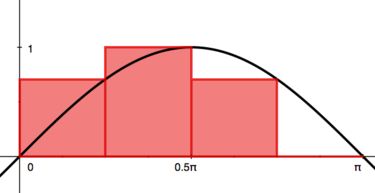Difference between revisions of "009B Sample Midterm 3, Problem 1"
Jump to navigation
Jump to search
| Line 1: | Line 1: | ||
[[File:9B_SM3_1_GP.png|right|375px]] | [[File:9B_SM3_1_GP.png|right|375px]] | ||
| − | <span class="exam">Divide the interval <math style="vertical-align: -5px">[0,\pi]</math> into four subintervals of equal length <math>\frac{\pi}{4}</math> and compute the right-endpoint Riemann sum of <math style="vertical-align: -5px">y=\sin (x).</math> | + | <span class="exam">Divide the interval <math style="vertical-align: -5px">[0,\pi]</math> into four subintervals of equal length <math>\frac{\pi}{4}</math> and compute the right-endpoint Riemann sum of <math style="vertical-align: -5px">y=\sin (x).</math> |
| Line 7: | Line 7: | ||
!Foundations: | !Foundations: | ||
|- | |- | ||
| − | | | + | | |
| + | '''1.''' The height of each rectangle in the right-hand Riemann sum | ||
|- | |- | ||
| − | | | + | | is given by choosing the right endpoint of the interval. |
| − | |||
|- | |- | ||
| | | | ||
| − | + | '''2.''' See the Riemann sums (insert link) for more information. | |
|} | |} | ||
| + | |||
'''Solution:''' | '''Solution:''' | ||
| Line 20: | Line 21: | ||
!Step 1: | !Step 1: | ||
|- | |- | ||
| − | |Let <math style="vertical-align: -5px">f(x)=\sin(x) | + | |Let <math style="vertical-align: -5px">f(x)=\sin(x).</math> |
|- | |- | ||
| − | | | + | |Each interval has length <math>\frac{\pi}{4}.</math> |
| + | |- | ||
| + | |Therefore, the right-endpoint Riemann sum of <math style="vertical-align: -5px">f(x)</math> on the interval <math style="vertical-align: -5px">[0,\pi]</math> is | ||
|- | |- | ||
| | | | ||
| − | + | <math>\frac{\pi}{4}\bigg(f\bigg(\frac{\pi}{4}\bigg)+f\bigg(\frac{\pi}{2}\bigg)+f\bigg(\frac{3\pi}{4}\bigg)+f(\pi)\bigg).</math> | |
|} | |} | ||
| Line 34: | Line 37: | ||
|- | |- | ||
| | | | ||
| − | + | <math>\begin{array}{rcl} | |
\displaystyle{\frac{\pi}{4}\bigg(\sin\bigg(\frac{\pi}{4}\bigg)+\sin\bigg(\frac{\pi}{2}\bigg)+\sin\bigg(\frac{3\pi}{4}\bigg)+\sin(\pi)\bigg)} & = & \displaystyle{\frac{\pi}{4}\bigg(\frac{\sqrt{2}}{2}+1+\frac{\sqrt{2}}{2}+0\bigg)}\\ | \displaystyle{\frac{\pi}{4}\bigg(\sin\bigg(\frac{\pi}{4}\bigg)+\sin\bigg(\frac{\pi}{2}\bigg)+\sin\bigg(\frac{3\pi}{4}\bigg)+\sin(\pi)\bigg)} & = & \displaystyle{\frac{\pi}{4}\bigg(\frac{\sqrt{2}}{2}+1+\frac{\sqrt{2}}{2}+0\bigg)}\\ | ||
&&\\ | &&\\ | ||
| Line 40: | Line 43: | ||
\end{array}</math> | \end{array}</math> | ||
|} | |} | ||
| + | |||
{| class="mw-collapsible mw-collapsed" style = "text-align:left;" | {| class="mw-collapsible mw-collapsed" style = "text-align:left;" | ||
!Final Answer: | !Final Answer: | ||
|- | |- | ||
| − | | <math>\frac{\pi}{4}(\sqrt{2}+1)</math> | + | | <math>\frac{\pi}{4}(\sqrt{2}+1)</math> |
|} | |} | ||
[[009B_Sample_Midterm_3|'''<u>Return to Sample Exam</u>''']] | [[009B_Sample_Midterm_3|'''<u>Return to Sample Exam</u>''']] | ||
Revision as of 11:18, 9 April 2017
Divide the interval into four subintervals of equal length and compute the right-endpoint Riemann sum of
| Foundations: |
|---|
|
1. The height of each rectangle in the right-hand Riemann sum |
| is given by choosing the right endpoint of the interval. |
|
2. See the Riemann sums (insert link) for more information. |
Solution:
| Step 1: |
|---|
| Let |
| Each interval has length |
| Therefore, the right-endpoint Riemann sum of on the interval is |
|
|
| Step 2: |
|---|
| Thus, the right-endpoint Riemann sum is |
|
|
| Final Answer: |
|---|

![{\displaystyle [0,\pi ]}](https://wikimedia.org/api/rest_v1/media/math/render/svg/3e2a912eda6ef1afe46a81b518fe9da64a832751)







